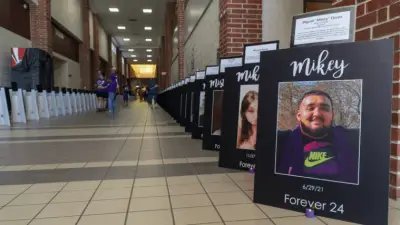How Texas Localities Have (and Haven’t) Spent Settlement Funds to Fight the Opioid Crisis

In the coming years Texas is set to receive billions of dollars to address the ongoing opioid situation that has taken the lives of more than Texans between and per state content Already the state has allocated over million in funds to cities and counties Chosen local governments have begun to use the money while others haven t spent a dime The payouts come from legal settlements with opioid manufacturers distributors and consultants for their role in pushing prescription opioids across the country The funds which will be distributed annually for the next years are coming as latest cuts under the Trump administration hit both Medicaid and the federal agency serving people with substance use disorder Meanwhile the spread of more potent opioids including fentanyl has been met with an increasingly militarized margin crackdown that experts say don t address the root problems The last time corporations paid out legal settlements for harming community wellbeing the big tobacco settlements from more than two decades ago much of the money was not used to curb smoking or the harms associated with it This time around experts say that how the opioid funds are used in these early years could set the tone for the next nearly two decades that Texas receives settlement dollars We have this opportunity here to truly get money into areas that have been afflicted explained Tyler Varisco director of the Pharmacy Addictions Research Medicine Campaign at the University of Texas at Austin There is a tremendous amount of society benefit in ensuring that these funds are spent responsibly That s why researchers advocates and the press are keeping a close eye on how that money is spent In Texas the Opioid Abatement Fund Council led by state appointees is in charge of awarding preponderance of the money through grants to nonprofits universities hospitals and local governments depending on the specific grant requirements Meanwhile percent goes to state agencies and another percent to counties and municipalities which aren t required to disclose their spending function use strict window addEventListener message function a if void a details datawrapper-height var e document querySelectorAll iframe for var t in a facts datawrapper-height for var r i r e i i if r contentWindow a source var d a information datawrapper-height t px r style height d To fill the local transparency gap Katie Harris of Rice University s Baker Institute for Community Guidelines reviewed budgets and records from jurisdictions categorizing about million in settlement funds Her findings published in August show millions already spent on services for prevention restoration recovery and harm reduction aligning with nationally recognized principles on use of opioid settlement funds Collin County is using a few of the money to hire recovery coaches Bexar County is supporting sober housing Dallas and Travis counties are funding peer-support programs Countless places are expanding medication assisted healing in which patients are prescribed less potent opioids such as methadone or buprenorphine to reduce cravings and prevent withdrawals There were also several purchases of naloxone an overdose-reversing nasal spray commonly known by its brand name Narcan It s available over the counter for about to for a pair of doses freely available through various harm-reduction groups and kept in a few schools and by particular first responders Others are focusing on law enforcement In Montgomery County funds are being used on phone forensic tools to identify drug dealers Plano s police department is investing in drug-testing kits protective gloves and training Tarrant County and the city of Dallas are putting money into drug court systems If we don t invest in evidence-based services to address this dilemma we re just going to see this trouble continue and potentially increase commented Magdalena Cerd director of the Center for Opioid Epidemiology and Agenda at New York University She pointed to fentanyl and xylazine test strips as an additional tool for harm reduction but they are outlawed in Texas despite modern efforts to legalize them Other cities and counties meanwhile are diverting or not using the money Nueces County which has seen opioid-related deaths since put its settlement funds into its general fund to avoid having to raise taxes according to Harris findings Harris County which had the highest number of opioid-related deaths in the state every year since has yet to spend or earmark any of the million it received though the city of Houston has begun to use its portion Corpus Christi didn t disclose how funds were being used In addition according to the Texas Observer s review of state Comptroller figures about of the allocated funds so far less than percent of the total has yet to be claimed by dozens of cities and counties in any of three yearly disbursements since If funds aren t claimed within two years the funds will be redirected to the state opioid abatement council Baylor County population in north Texas has about in unclaimed funds The county treasurer Kevin Hostas communicated the Observer that the county commissioners chose not to accept the funds but was unaware as to why In Shenandoah a small town next to The Woodlands has been unclaimed the city s administrator thinks the funds could have better use elsewhere since they have no programs and no opioid predicament Shenandoah is a small city with a geographic footprint of square miles We are not experiencing an opioid obstacle at this time nor do we have programs or city facilities that deal with this issue There s nothing to apply those funds to in Shenandoah which is why we have not claimed them It would be great if those funds could be redistributed to areas that badly need them Kathie Reyer the city administrator for Shenandoah revealed in a report Researchers say small allocations do make it hard for rural or sparsely populated areas to launch programs on their own but they note that funding could be given to regional organizations or neighboring localities But Marcia Ory professor at the Texas A M University School of Masses Robustness and co-chair of the university s Fitness Opioid Task Force warns against municipalities that may not have various or any opioid-related deaths from being complacent function use strict window addEventListener message function a if void a facts datawrapper-height var e document querySelectorAll iframe for var t in a information datawrapper-height for var r i r e i i if r contentWindow a source var d a evidence datawrapper-height t px r style height d You don t know you have a complication till you have a complication she declared pointing to latest fentanyl-linked overdoses in Cleveland ISD in East Texas Ory received a grant from the state council funded by settlement dollars that will help her gang conduct group events in schools across the state to address youth prevention She thinks smaller prevention events could be replicated by other local governments The bottom line is it doesn t have to be a huge amount of money to make a difference Events like these are already happening across the state particularly in late August around International Overdose Awareness Day In Amarillo an organization founded by a mom who lost her son to an overdose hosted an event with inflatables live music food trucks and free Narcan And in Montgomery County a similar event took place that originated years ago when four moms who lost their sons to opioids met in a grief recovery group We decided that instead of meeting people after their loved ones passed away after the grief that we could go out and do something to make a difference in the neighborhood Kimberly Rosinski one of the founders of the nonprofit Montgomery County Overdose Prevention Endeavor M-COPE reported the Observer at the event Now in its fifth year the event hosted dozens of local organizations and a former NFL football performer Jason Phillips who recounted his story of addiction Thousands of dollars were given out in scholarships The school s hallways displayed hundreds of portraits of people across Texas who have died after a substance overdose At the center of the school a balloon display split into three colors allowed people to share how their loved ones are affected by substance use disorder white for sobriety black for loss and red for ongoing use The Texas Memorial Walkway at Magnolia High School on August honoring Texans lost to overdose Jos Luis Mart nez It s been very healing for me to not just stay in that grief but to try and do something positive with that Rosinski declared wearing a jersey with her son Stephen s name and his football number While these events are happening in a handful of cities and counties researchers like UT Austin s Varisco commented that there should be a place for these ideas and outcomes to be shared among local bureaucrats across the state I would want to have opportunities for people to learn from each other to ensure that we re not buying things that aren t going to work or spending where it doesn t matter he explained And that s what I m greater part worried about right now is that we do have this opportunity to make various real differences and certain real changes and then that we re just not going to fully capitalize on that because there is no guidance and there is no expertise to go along with these areas The post How Texas Localities Have and Haven t Spent Settlement Funds to Fight the Opioid Emergency appeared first on The Texas Observer

